|
English Electric Canberra
B(I)8 and PR.9
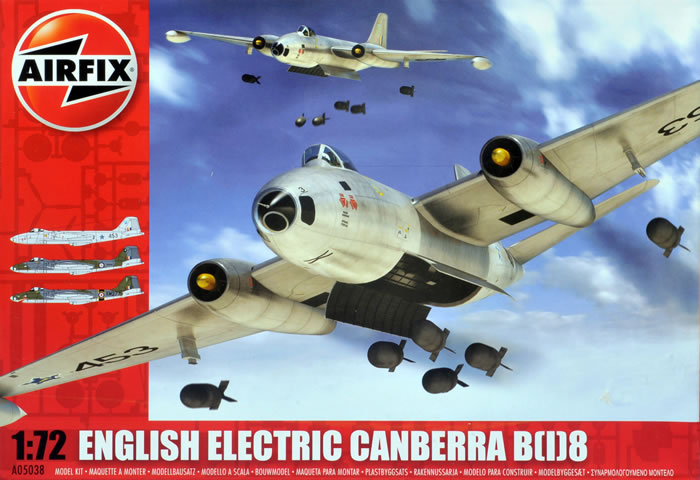
Airfix 1/72 scale
S
u m m a r y |
| Description and Catalogue Number: |
Airfix A05038 English Electric Canberra B(I)8 and Airfix A05039 English Electric Canberra PR.9 |
| Scale: |
1/72 |
| Contents and Media: |
Canberra B(I)8: 135 parts arranged on six sprues of soft grey styrene; 7 parts in clear styrene; decals for three subjects.
Canberra PR.9: 108 parts arranged on six sprues of soft grey styrene; 17 parts in clear styrene; decals for four subjects. |
| Price: |
From £11.91 available online from Hannants.
USD$19.13 available online from Squadron |
| Review Type: |
FirstLook |
| Advantages: |
Generally accurate outline, decent surface detail with engraved panel lines, Comprehensive decals. |
| Disadvantages: |
Panel lines are a little exaggerated. Fin fillet too deep. |
| Conclusion: |
An excellent effort. While not without some issues (the panel lines in particular), these have the potential to make pleasing models straight from the box, while also serving as a sound basis for a super-detailed masterpiece. |
Reviewed by Peter Mitchell
2009 marked 60 years since the prototype E.E. Canberra first took to the air. Over that time the Canberra has served over fifty years in the inventory of a host of air forces and seen combat with the RAF in the Suez Crisis, the RAAF in Vietnam and with the Indian Air Force.
The conventional “bubble top” canopy that featured the majority of Canberra versions is the vision that probably springs to most people’s minds when they think of the E.E. Canberra. However, two other major types, the B(I).8 and the PR.9 came from a redesigning of the nose and cockpit area.
These featured a new raised fighter style canopy that provided improved all around visibility. The B(I).8 was designed for the interdiction role and had the capacity of carrying a wide range of under wing ordnance, plus the option of a Boulton-Paul gun pack with four 20mm Hispano cannon mounted on the rear bomb-bay.
The PR.9 featured larger square tipped wings and was powered by more powerful Rolls-Royce Avon Mk 206 turbo-jets.
Given that the E.E. Canberra has been in service for so long it seems surprising that it was not until 1974 that it was represented by a mainstream 1/72 kit; first by FROG who produced a B(I).8/Mk 12 then rapidly followed by Airfix, who produced a B2/B20 version that was sadly latter modified to a B-57. Around about 1980, Matchbox joined in and completed the set, producing a PR.9.
All of these kits were products of their time; simple, lacking in detail and with the odd outline error.
A further thirty years passed before more modern and detailed kits appeared on the scene from Xtrakit and Highplanes. These are however of the short-run variety and pose more of a challenge to put together.
Now Airfix have rejoined the fray, bringing the 1/72 modelling world two completely newly tooled Canberra kits of the B(I).8 and PR.9 versions.
Well, they’re almost new, as they appear to be pantographed down versions of the excellent 1/48 Airfix E.E. Canberra kits.
The kits come packaged in Airfix’s new, sturdy bright red top opening boxes and contain the main parts and the transparencies separately bagged from each other. The boxes are huge! At first I thought these were 1/48 scale kits. The completed model (not small by any means) will fit inside with a little angling.
The instructions are printed on a six to eight page double sided A4 booklet. These feature a short history of the E.E. Canberra in five European languages, detailed construction sequence over thirty or so steps and also include a beautifully presented full colour paint and decal guide for the three or four versions offered. The colour call outs are provided for the Humbrol colour range.
The plastic parts are moulded in a soft light grey styrene, panel lines are engraved and there is hardly any flash or ejector towers in any obvious places. Some shrinkage dimples are present on the wing surfaces were there are alignment pins. The parts have multiple sprue attachments but these are for the most part quite thin. If I am critical of anything it would be the width of the panel lines. The engraving here seems rather heavy, but the effect will quite likely improve with some light sanding and a coat of paint, some modellers may wish to fill them.
Comparison of the main components of the B(I).8 kit with scale plans provided in Scale Models International (January 1984 p18), shows that Airfix have done a good job in producing a product with accurate shape and outlines. The only areas that warrant attention are those that have been noted by reviewers of the 1/48 kit; basically the fin fillet is a little too deep and the elevator tips need rounding off, nothing that cannot be simply and rapidly corrected.
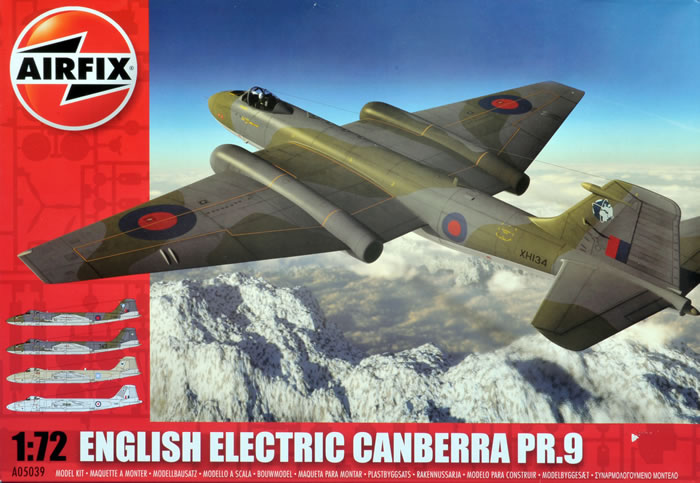
The PR.9 version comes with a different (longer) fuselage and larger span wings complete with vortex generators on top. The later are perhaps a little thick, but I think they are fit for purpose in this scale. Again there is the same issue with the fin fillet and the elevator shape, additionally the intakes on top of the starboard engine are incorrectly placed and the shape of the outboard flaps can be improved. A very comprehensive assessment and list of improvements for the 1/48 version can be found at the following link http://ipmsuk.proboards.com/index.cgi?boar...amp;thread=4445
This site is an excellent resource for anyone building the PR.9 version.
While on the subject of web resources, have look at the Canberra tribute site http://www.bywat.co.uk/wt346int.html
This contains a wealth of photos and a good deal of information on the B(I)8.
Both kits share a common sprue supplying cockpit interior, tailplanes, landing gear, wheel wells and doors as well as two detailed, but undersized crew figures with separate arms.
The crew compartment is divided into pilot cockpit and navigator sections, a floor, detailed side consuls, rudder bar, control yoke and instrument panel are provided. For some reason the B(I)8 kit has a “fighter” style joystick, where as it should be a “rams head” yoke as supplied with the PR.9 version. The ejection seats are of multi piece construction and come complete with seat harnesses, they are a little simple but can be made fit for purpose with some further detailing or simply replaced with an Aeroclub item. It should be remembered that the Canberra cockpit openings are not large and the predominant colour will be black, so not much is going to be seen at this scale anyway.
Like many other tricycle airframes the Canberra is going to be a tail sitter, Airfix recommends adding 45g of weight to the front section. This won’t pose to big a problem the case of the PR.9, however the modeller may need to get creative when making the B(I).8.
The turbine fronts of the Rolls Royce Avon engines are well represented and these are designed to slip in behind the engine nacelles lips. The fronts can be further detailed with starter cartridge exhaust ducts.
The landing gear detail is perhaps on the soft side, however these will still come up well with a dry brushing and an oil wash. The wheel-wells are boxed and have structural detailing. The tyres have tread and are realistically flattened. The mud-guards for the front wheels are separate items.
The B(I).8 kit has the option of using the detailed bomb-bay (complete with 4 x 1000 lb bombs) that can be modelled open or closed for the use of the Boulton-Paul four 20mm Hispano cannon gun pack.
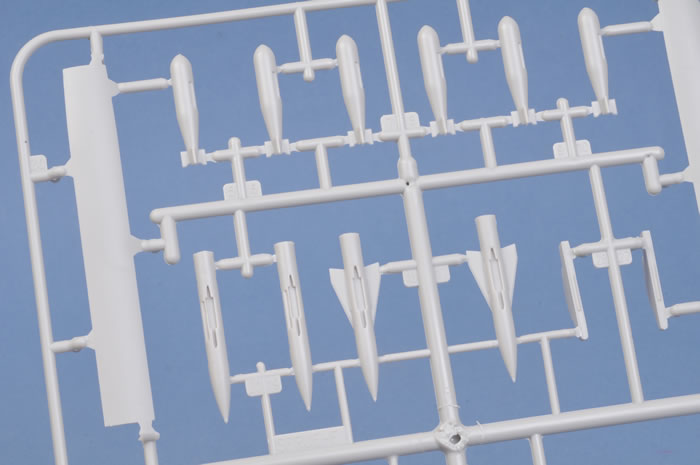
The PR.9 comes with optional two different camera pack inserts for the bomb-bay. These come with separate transparencies for the camera covers.
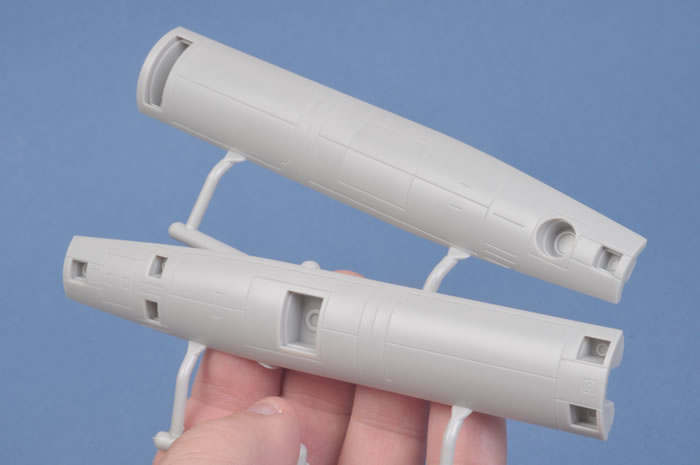
Under wing ordinance options are provided for both versions. In the case of the B(I)8 kit there is a whole arsenal to choose from: 1000 lb bombs, rocket pods and AS30 missiles.
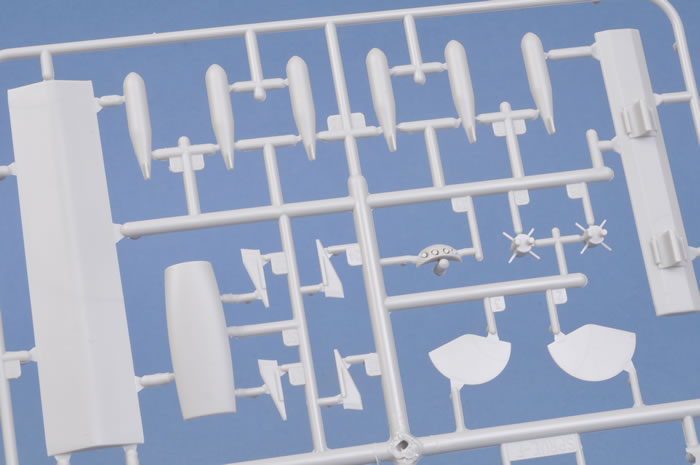
The PR.9 version comes with a set of viscous looking missile things that I’ve been told are chaff pods (but I haven’t seen them on any photos of a PR.9).
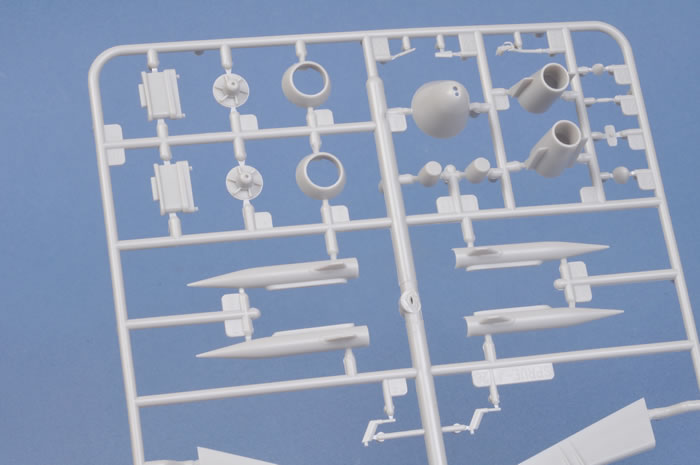
The kit transparencies are clear and distortion free.
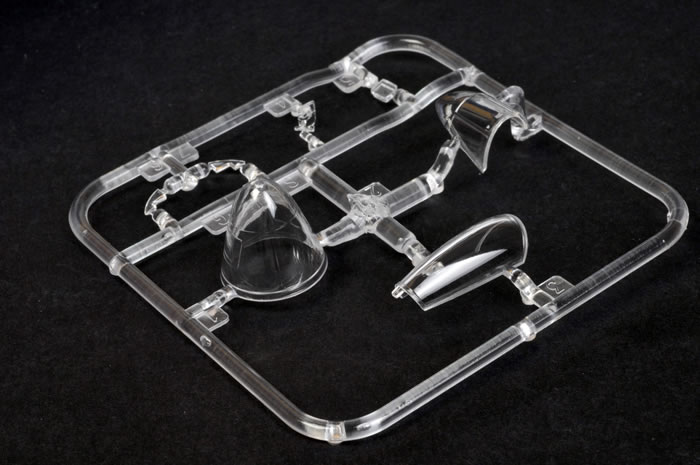
In the case of the PR.9 kit, the cockpit canopy can be modelled in the open position.
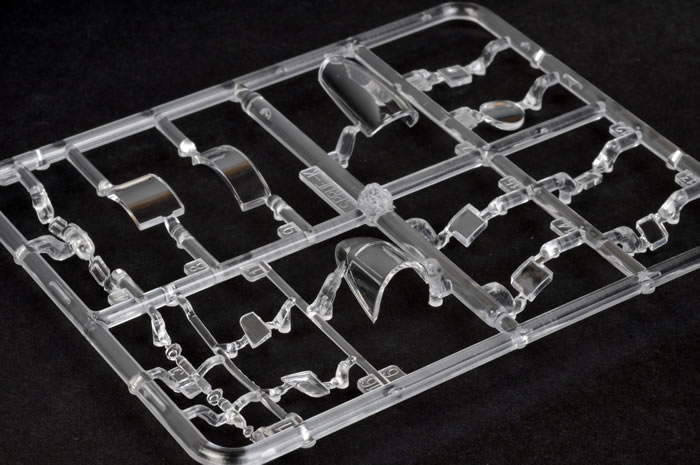
Markings
The decals are well printed and a great improvement over previous efforts from Airfix. Printed on glossy paper, they are very comprehensive, providing a plethora of stencils, the detail is fine enough for even the small print to be legible. The colour grades appear to be correct and the register on my sample was perfect.
The modeller is given the choice of three colour scheme options for the Canberra B(I)8:
-
Canberra B(I)8, XM277. 16 Sqn. Royal Air Force, Laarbruch, Germany, 1972. Dark Green/Dark Sea Grey over High Speed Silver (and a snazzy shark mouth motif).
-
Canberra B(I)12, NZ6106. 14 Sqn. Royal New Zealand Air Force, Ohakea, 1968. Dark Green/Dark Sea Grey over High Speed Silver
-
Canberra B(I)12, 453. 12 Sqn. South African Air Force, 1968-1975. All over High Speed Silver
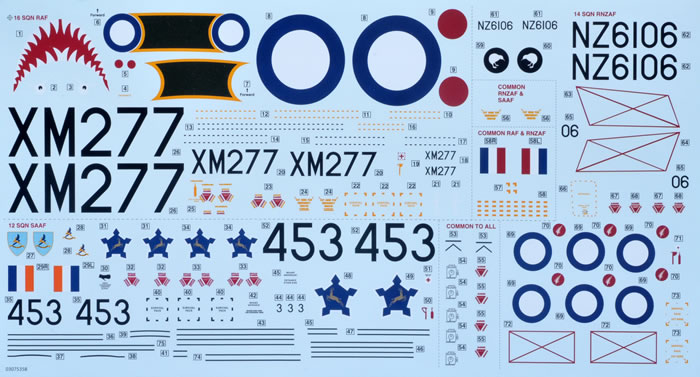
...and the choice of four colour scheme options for the Canberra PR.9:
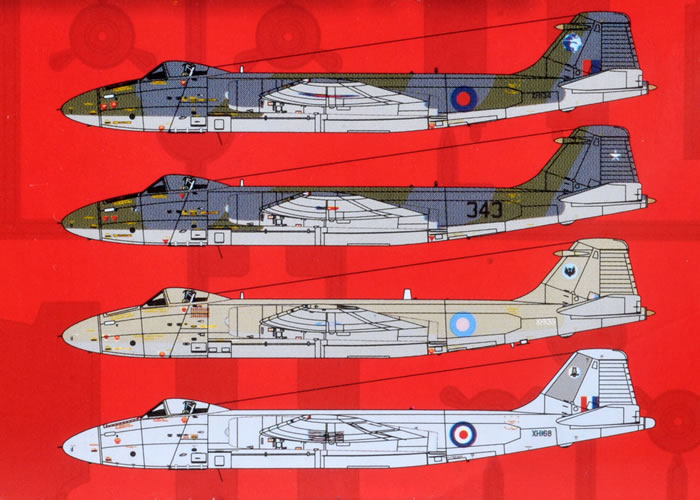
-
Canberra PR.9, XH135. 39 Sqn. Royal Air Force, Marham, UK, July 2006. RAF Hemp over Light Aircraft Grey with low-vis roundels.
-
Canberra PR.9, XH134. No.1 PRU, Royal Air Force, Wyton, UK, November 1985. Dark Green/Dark Sea Grey over Light Aircraft Grey with Type B roundels.
-
Canberra PR.9, 343. Grupo 2. Chilean Air Force, 1983. Dark Green/Dark Sea Grey over Light Aircraft Grey.
-
Canberra PR.9, XH168. 58 Sqn. Royal Air Force, Wyton, UK, November 1985. All over High Speed Silver with Type A roundels.
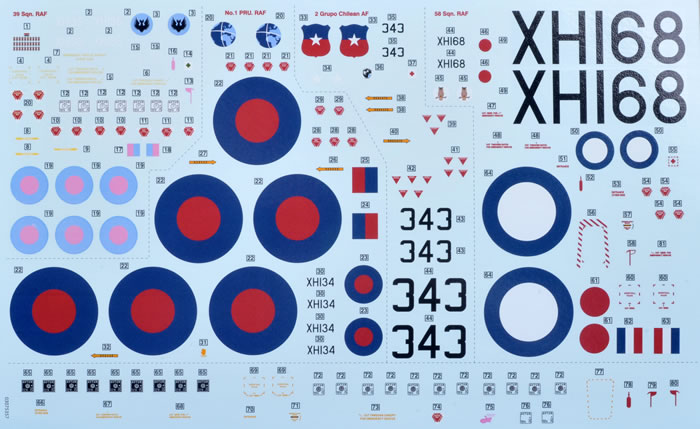
I think Airfix have made an excellent effort in producing two new Canberra kits in 1/72. While not without some issues (the panel lines in particular), these have the potential to make pleasing models straight from the box, while also serving as a sound basis for a super-detailed masterpiece.
Further reading:
Scale Models January 1974 p30. A short article introducing the “new” FROG 1/72 Canberra B(I)8 along with 1/96th scale plans.
Scale Models October 1976 p490. A review the Airfix 1/72 Canberra B(1)6 which discusses some corrections for this kit as well as some very useful information detailing the position of various wing and engine intake ducts for R-R Avon 109 engined Canberra’s such as the B(I)8.
Scale Models January 1984 p16. Ray Rimell combines the FROG 1/72 Canberra B(I)8 with the Airfix 1/72 Canberra B(1)6 to make an improved Canberra B(I)8. Excellent 1/72nd scale plans in this article.
PAM News June 1980 p18.
Samples purchased locally by reviewer.
Text Copyright © 2010 by Peter Mitchell
Images Copyright © 2010 by Brett Green
Page Created 5 February, 2010
Last updated
5 February, 2010
Back to HyperScale Main Page |
